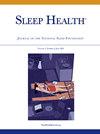美国成年人不同叶酸状态与睡眠障碍的关系:数据来自NHANES 2007-2016。
IF 3.4
2区 医学
Q2 CLINICAL NEUROLOGY
引用次数: 0
摘要
目的:探讨成人三种叶酸状态(叶酸摄入量、血清叶酸和红细胞叶酸)与睡眠障碍之间的关系。方法:采用Cochran-Armitage试验对连续5个周期的睡眠障碍趋势进行评估。使用调查加权逻辑回归模型、受限三次样条模型和交互分析来评估叶酸不同状态与睡眠障碍之间的关系。结果:这项横断面研究包括来自5个NHANES周期(2007-2016)的20,200名符合条件的成年人。随着时间的推移,睡眠障碍的总体粗患病率从2007-2008年的25.8%(95%可信区间,23.6%,28.0%)上升到2015-2016年的29.3%(95%可信区间,25.9%,32.9%)(P为趋势)。结论:我们观察到美国成年人叶酸摄入量、血清叶酸、红细胞叶酸和睡眠障碍之间存在u型相关性。本文章由计算机程序翻译,如有差异,请以英文原文为准。
Association of different folate statuses with sleep disturbances in adults in the US: Data from NHANES 2007-2016
Objective
To explore the associations between three folate statuses (folate intake, serum folate, and red blood cell folate) and sleep disturbances in adults.
Methods
Trends in sleep disturbances in five consecutive cycles were evaluated using Cochran–Armitage tests. Survey-weighted logistic regression models, restricted cubic spline models, and interaction analysis were used to evaluate the associations between different statuses of folate and sleep disturbances.
Results
This cross-sectional study included 20,200 eligible adults from five cycles of NHANES (2007-2016). The overall crude prevalence of sleep disturbances increased over time from 25.8% (95% confidence intervals, 23.6%, 28.0%) in 2007-2008 to 29.3% (95% confidence intervals, 25.9%, 32.9%) in 2015-2016 (P for trend <.001). In adjusted, weighted multivariable regression models, compared to the second quartile (Q2), lower folate intake levels (Q1, odds ratio = 1.22, 95% confidence intervals: 1.06, 1.40), higher folate intake levels (Q4, odds ratio = 1.18, 95% confidence intervals: 1.01, 1.38), and higher red blood cell folate levels (Q4, odds ratio = 1.17, 95% confidence intervals: 1.03, 1.33) were independently associated with higher odds of sleep disturbances. The restricted cubic spline models revealed U-shaped, nonlinear associations between different folate statuses and the risk of sleep disturbances. A daily folate intake of approximately 439 mcg, a serum folate concentration of approximately 35 nom/L, and an red blood cell folate concentration of approximately 886 nmol/L were associated with the lowest risk of sleep disturbances. The results were robust in interaction and sensitivity analyses.
Conclusions
We observed U-shaped associations between folate intake, serum folate, red blood cell folate, and sleep disturbances among US adults.
求助全文
通过发布文献求助,成功后即可免费获取论文全文。
去求助
来源期刊

Sleep Health
CLINICAL NEUROLOGY-
CiteScore
6.30
自引率
9.80%
发文量
114
审稿时长
54 days
期刊介绍:
Sleep Health Journal of the National Sleep Foundation is a multidisciplinary journal that explores sleep''s role in population health and elucidates the social science perspective on sleep and health. Aligned with the National Sleep Foundation''s global authoritative, evidence-based voice for sleep health, the journal serves as the foremost publication for manuscripts that advance the sleep health of all members of society.The scope of the journal extends across diverse sleep-related fields, including anthropology, education, health services research, human development, international health, law, mental health, nursing, nutrition, psychology, public health, public policy, fatigue management, transportation, social work, and sociology. The journal welcomes original research articles, review articles, brief reports, special articles, letters to the editor, editorials, and commentaries.
 求助内容:
求助内容: 应助结果提醒方式:
应助结果提醒方式:


